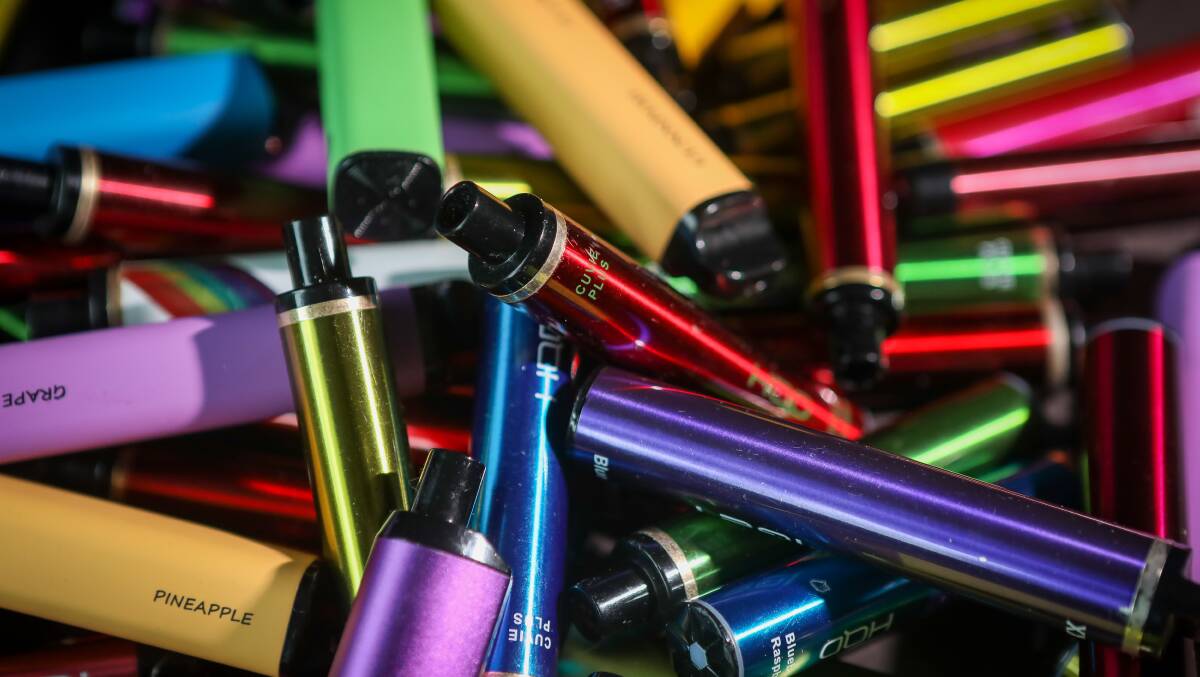Vaping use has tripled in the last four years, and seen a huge uptick among teenagers, new data reveals.
The Australian Institute of Health and Welfare's National Drug Strategy Household Survey 2022-2023 results were published on Thursday.
Only 1.2 per cent of Australians regularly vaped in 2016.
This rose to 2.5 per cent in 2019, and seven per cent in 2022-23.
One in five Australians reported using an e-cigarette in their lifetime, twice as many than in 2019.
Stricter federal vaping regulations came into force in January this year.
The importation of non-therapeutic vapes has been illegal since March 1.
Big uptick in teens vaping
More than one in 10 teenagers aged 14 to 19 were regular vapers in the last financial year.
Teenagers 3.5 times more likely to regularly vape in the last financial year compared to six years ago.
The rise is from 1.5 per cent in 2016, 2.8 per cent in 2019 and 12.8 per cent in 2022-23.
However, the majority of teenagers that age - 66 per cent - had never tried an e-cigarette.
One of the age groups with the highest increase in e-cigarette use is 14 to 17-year-olds, Professor Simone Pettigrew, of The University of NSW, said.
"Substantial increases in vaping rates, especially among young people, are the result of an insidious industry finding innovative methods of keeping youth addicted to nicotine to assure long-term sales," he said.
Retired Associate Professor Dr Colin Mendelsohn, previously of the University of NSW, believes these young people may be vaping instead of smoking.
"The uptick in youth vaping has not led to increased smoking by youth (14-17-year-olds)," he said.
"Daily youth smoking fell from 1.9 per cent in 2019 to 1.5 per cent in 2023. This provides further evidence that ... vaping is more likely diverting them away from smoking."
Emeritus Professor of Public Health at the University of Sydney, Simon Chapman, disagreed.
"Many studies show that young people who start vaping have a three-fivefold probability of smoking down the track," he said.

Cancer Council NSW says vapes still contain dangerous toxins, including those known to cause cancer.
"Even vapes that don't contain nicotine (although most do) aren't safe and can have negative, life-long impacts, especially on growing brains and bodies," they said.
Young people take up vapes
Nearly one-in-three Australians aged between 20 and 29 regularly vaped in the last financial year.
Nearly 13 times more 20-29 year olds vaped in 2022-23 compared to 2016.
This was a rise from only 2 per cent to 27.2 per cent.
About half of people under 30 have had an e-cigarette at least once, drug and alcohol researcher Associate Professor Elizabeth Temple, from the University of New England, said.
"[Only] a small portion of this group have progressed to daily vaping, which may be indicative of nicotine addiction or dependence," she said.
The University of Technology Sydney's Professor Brian Oliver said the data regarding young people and vaping may be misleading.
He said people are considered regular users of e-cigarettes if they use them from daily to less than monthly.
"There is an over-estimation of the number of actual daily users of electronic cigarettes, and perhaps more importantly the number of people addicted to nicotine," he said.
The 18-24 year old people were the group most likely to use e-cigarettes (21 per cent), but less than half of these used them on a daily basis. This means that 90 per cent of young adults are not daily users of e-cigarettes.
"Most young people in Australia are not e-cigarette users no matter how the data is presented."
Younger age groups are more likely to smoke e-cigarettes but less likely to use tobacco.
Smoking cigarettes
Only 8.3 per cent of Australians smoke tobacco daily.
The proportion of people who have never smoked continues to rise, up from 49 per cent in 1991 to 65 per cent in 2022-2023.
Illicit drug use
Around one-in-five people aged 14 and over had used an illicit drug in the previous 12 months.
More people used hallucinogens (1.6 per cent to 2.4 per cent) and ketamine (0.9 per cent to 1.4 per cent), from 2019 to 2022-23.
The use of cannabis and cocaine remained fairly stable between 2019 and 2022-23.
Fewer people used ecstasy and non-medical use of pain relievers and opioids.
READ MORE:
For the first time ever, males and females aged 18-24 are equally likely to use illicit drugs.
Media coverage around the use of hallucinogens for mental health might be behind the increase, senior lecturer in addiction at Edith Cowan University, Dr Stephen Bright, said.
"Use of psychedelic drugs has significantly increased making them the third most popular illegal drugs in Australia after cannabis and cocaine," he said.
"However, without the support of trained professionals, Australians who attempt to treat their mental illness using illicit drugs could unwittingly make their mental health worse or place themselves at risk of harm from underground psychedelic treatment providers."
Booze still big
Three-quarters of Australians drank alcohol in the 12 months before they were surveyed.
Around one in three people drank alcohol in ways that put their health at risk in 2022-2023.
"The proportion of people in Australia who drink alcohol at risky levels has not changed since 2019," Dr Gabrielle Phillips said.
Males were more likely to drink at risky levels than females.
However, females are increasingly more likely to drink at dangerous levels.


